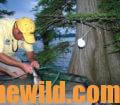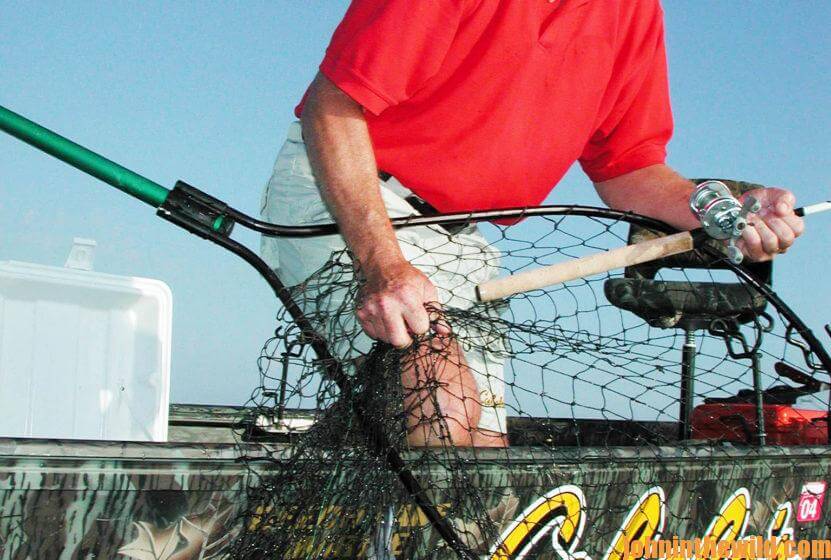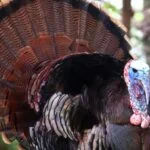Editor’s Note: Catfish are hard-fighting and delicious to eat. The equipment you need to catch cats is inexpensive and easy to find, and the ways you can catch catfish successfully are numerous. The largest catfish on record is a 9-foot long, 646-pound Mekong giant catfish caught in China.
Phil King (662-286-8644) of Corinth, Mississippi, guides for catfish at Pickwick Lake but fishes all over the nation in catfish tournaments. One of his favorite ways to fish is to troll. “When I slow-troll for catfish, I troll the slack-water sections of the water near a dam. When I’m trolling, I’m strictly fishing for big fish, weighing from 12 to 50 pounds. I’m using a variable-speed trolling  motor, and I’m using my depth finder to look for humps, rocks and any type of bottom break I can find that should hold big cats. I believe the big catfish hold in the slack water instead of the current, because they’re resting. They are close enough to the current, so they can move-out into it with very little effort and feed. Then they can move-back into the slack water and rest without having to fight the current.
motor, and I’m using my depth finder to look for humps, rocks and any type of bottom break I can find that should hold big cats. I believe the big catfish hold in the slack water instead of the current, because they’re resting. They are close enough to the current, so they can move-out into it with very little effort and feed. Then they can move-back into the slack water and rest without having to fight the current.
“I fish with 7-foot flipping sticks with bait-casting reels. I use 60- to 65-pound-test braided line, because I want small-diameter line that will get down quickly but have the strength in the line to be able to land a really-big catfish. On the main line, I’ll tie a heavy-duty three-way swivel. Coming off the second eye of the three-way swivel, I’ll tie 2 feet of 60-pound test Berkley Big Game monofilament line https://www.berkley-fishing.com/. And to the end of this line, I tie either a No. 5/0 or a No. 8/0 Daiichi Octopus hook. I also use Eagle Claw No. 7/0 hooks https://www.eagleclaw.com/. On the bend of the hook, I’ll tie 2 to 4 inches of 60-pound-test Berkley Big Game line and add a second hook. I like to fish with two hooks for big catfish, because I generally fish with really-big baits and will need two hooks to hold a large bait. I’ve also learned that I’ll catch 20-to 30-percent-more cats by 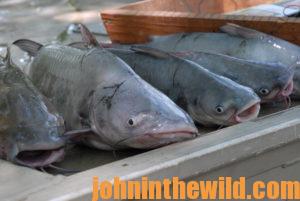 having that second hook.
having that second hook.
“Coming from the third eye of the three-way swivel, I’ll tie 2 feet of 60-pound-test monofilament line and tie-on a second barrel swivel. I’ll rig it the same way that I rig the drop hook on the first three-way swivel. On the last eye of the swivel, I’ll tie 2 feet of 60-pound-test line and attach a lead sinker that will weigh from 1 ounce to 4 ounces. The size of the sinker I’m using is determined by the depth of water I’m fishing, the amount of current that’s running, and the size of bait with which I’m fishing.
“I like to fish high off the bottom, since I’ve learned that the smaller cats stay closer to the bottom than the bigger blue cats do, unless the current is running strong where you’re fishing. Even the bigger flathead catfish usually will hold well-up off the bottom. I fish baits that are at least three-fingers wide and three-fingers long to try to catch bigger catfish. By using the double-drop system of rigging, I can troll from 2 – 6 feet off the bottom and troll two different types of baits to determine which kind of bait the catfish most prefer on that day.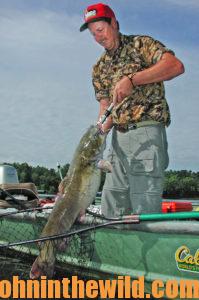
“I rely very heavily on my depth finder to be able to see the structure and the big, suspended fish. The big catfish always will be sitting on top of or beside stumps or rocks. The catfish may be holding so tight to the structure that you can’t differentiate that fish from the structure. You’ve got to have that depth finder to find the big catfish’s house and to possibly see it out on the front porch.”
Be sure to check how-many rods the state where you’re fishing allows each angler to use at one time. Also learn the distance you must be from a dam to troll in that
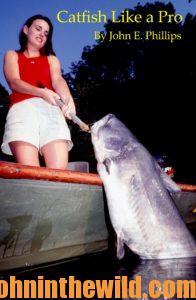 To learn more, check out John E. Phillips’s book, “Catfish Like a Pro” – at http://amzn.to/W900eu.
To learn more, check out John E. Phillips’s book, “Catfish Like a Pro” – at http://amzn.to/W900eu.
Tomorrow: How to Trotline Fish for Catfish and Care for Catfish

